I had heard a brief downpour during the night, but the dawn was glorious with a blue sky. I departed while others were still in the land of nod.
On the long climb back up the mesa, I stopped off to take in some views. The overlook was at 8000', and the vista stretched out for 100 miles or more. Vegetation at this altitude was lush, hence 'verde', and many wild flowers were in bloom. This morning I turned off towards the Wetherill Mesa section of Mesa Verde in order to pick up my third guided tour that would take me to Long House. The route along the mesa wound, climbed and descended through vast tracts of dead forests. The forests had been the so called pygmy forests; mainly pinyon pine and juniper. Lightening strikes were the arson culprits, and once started they were exceedingly difficult to get under control. The plumes were often so large that they would jump canyons and start fires on adjacent mesas. After a fire, grasses and ground growth soon returned, however the pygmy trees could take 150 - 200 years to get back to their original growth. I asked a ranger how many surface buildings had been exposed by the fires. "So far, 500", he replied.
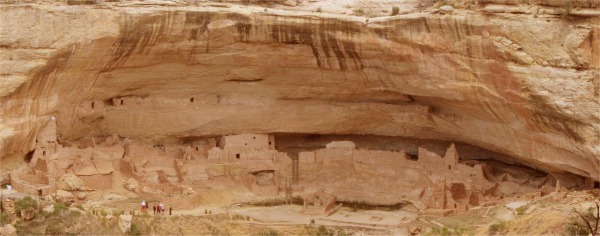
Long House
|
The Long House cliff dwelling was the second largest cliff dwelling, in fact just one room less than Cliff Palace. In both sets of dwellings, there were more rooms than people, and it was thought that those sites were used as centres for ceremonies. Long House had a more noticeable seepage stream than the other sites, though Spruce Tree House was fairly near a stream at the bottom of its valley. It was also unique in that it also had a large square shaped kiva. This was presumed to be for the more important religious gatherings.
Whilst we were walking around the dwellings, the guide discussed the farming strategy employed by the Puebloan people. The three crops cultivated were corn, beans and squash, which grew in harmony with each other. The corn grew tall, and the beans used the tall stems to curl around as they grew up towards the sun. The large squash leaves shaded the ground and helped to contain the moisture. Another important source of nutrition was the nuts that appeared every 3-6 years on the pinyon pine.
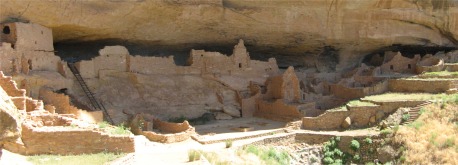
Examples of Dwellings
|
|
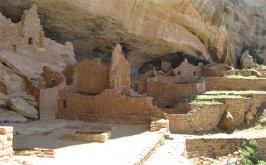
Further Examples of Long House Dwellings
|
|
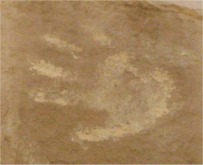
Hand Petroglyph
|
|
After the Long House tour, I visited the Badger House Community which featured a group of sites covering nearly seven acres. Walking through the sites was a journey through 600 years of prehistory mesa top dwellings.
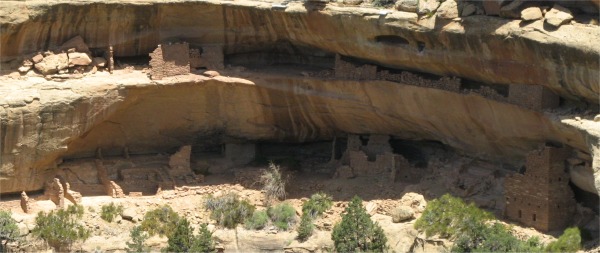
Kodak House
|
It was on this explore through time that I met Adam and Norma. Adam knew East Anglia where I now lived since he had been based there at one time at U.S.A.F. bases Mildenhall and Lakenheath. He had also visited the UK since on defence related issues, and said he enjoyed them since he got good coffee in the UK. This intrigued me since I thought Americans were long established coffee drinkers and would automatically be drinking the best. "Not so in the past", retorted Adam. It had only been in recent times that American consumers were pushing for a better product. The couple hailed from Arizona, but were spending an extended break up in Dolores, Colorado because it was relatively cool in comparison. They gave me some useful tips on Durango, my next port of call. As they left, they pointed out to me far away over the sunny landscape clouds with curtains of rain hanging below them, the rain evaporating before it reached the ground. As I gazed across at this phenomenon, a bolt of lightening snaked down from the cloud to the earth, but because of the distance, I never heard the thunder.
I was singularly impressed with the Mesa Verde National Park. It conveyed the history of the Puebloan peoples who eked out an existence both on top of the mesas and later in the cliff dwellings, their religious practices, and outstanding examples of the dwellings. I was left with the air of mystery too as to why they moved from the mesa tops to the cliff dwellings, and deserted en masse after only a century of occupation amongst the cliffs. As was often pointed out by the rangers, the historic site was not just the preserve of American history, but also of the world, and hence its listing as a World Heritage Site.
I left the site uplifted, and made my way across to Durango, the town the American humourist, Will Rogers, once said was "out of the way and glad of it". This small western town, tucked away in the horseshoe of the San Juan Mountains in the south-western corner of the state, had been the gateway to Southwestern Colorado's riches for more than 100 years. Indians and fur traders, miners and prospectors, ranchers and railroad engineers alike, have passed through Durango on their way to seek their fortunes. Many found that Durango was the treasure they sought.
Cars have replaced the covered wagon since Durango's founding, and one of the world's few surviving narrow gauge trains now hauls passengers instead of silver ore.
The river winding through the centre of the town, was named Rio de las Animas Perdidas (River of Lost Souls) by Spanish explorers. Today, locals just called it the Animas. Born in the wake of Colorado's gold and silver rush, Durango didn't make an appearance until the late 1800s, when the Denver and Rio Grande Railroad decided to build a branch to Silverton and establish Durango as the hub of its rail system, shipping rich ore from the mountains to the smelters in Durango.
After the mining boom ended, Durango emerged as a major tourism centre and cultural symbol of the West. The town was also a model of historic preservation, with late 19th century saloons and hotels lining Main Avenue, and elegant mansions from the same era on 3rd Street.
As soon as I hit town, I went and bought my ticket for the first train up to Silverton for the following morning. Once that was secure I found a campsite, fairly primitive but would suffice, and then headed back to town. One of the trains had pulled in so I went to the station to get a close view.
There I got chatting to a couple who turned out to be English, from Bristol, but had been living in Albuquerque, four hours drive away, for some time. I mentioned to the guy about the world's biggest hot air balloon festival taking place there every September. He knew all about it, he was a balloon pilot. We then rattled on about ballooning for quite a while, me covering my experiences in Europe, and he his flights around Albuquerque and also over in Durango. One interesting tale he told me was of a balloon meet at Durango, where one pilot did not take note at the briefing session, and ended up in a down draft which trapped his balloon on a ledge up a mountain. The crew had to be rescued by helicopter, but the balloon remains there to this day, the basket still tethered to a tree. I pointed out the problems folk were having in the UK with farmers, and he reciprocated by telling me that the insurance premiums were rising each year in the US, and he was having to consider whether to drop the hobby on cost grounds. Sadly, my stomach was rumbling, I hadn't eaten all day, so I made my apologies and left in search of food.
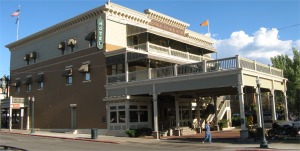
General Palmer Hotel
|
|
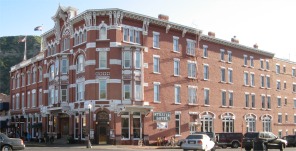
Strater Hotel
|
|
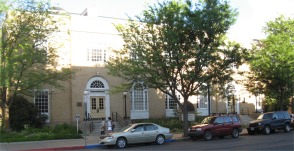
Old Main Post Office
|
|
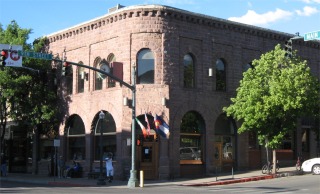
A Typical Main Avenue Building
|
|
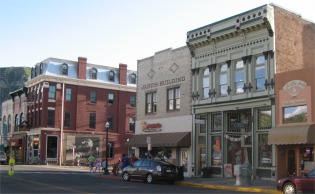
Another Main Avenue Set of Buildings
|
|
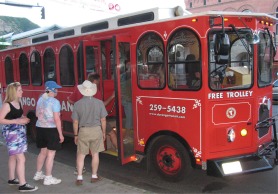
Trolley Bus
|
|
I wandered along Main Avenue in search of food, taking a few photos along the way. After I had eaten, all I wanted was sleep, so I headed back to the campsite, which was a bit of a trek, and was glad to get my head down. Tomorrow would be a very early start.











